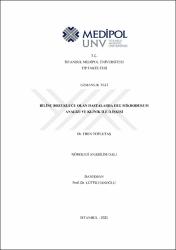Bilinç bozukluğu olan hastalarda eeg mikrodurum analizi ve klinik ile ilişkisi
Künye
Toplutaş, E. (2021). Bilinç bozukluğu olan hastalarda eeg mikrodurum analizi ve klinik ile ilişkisi. (Yayınlanmamış uzmanlık tezi). İstanbul Medipol Üniversitesi Tıp Fakültesi, İstanbul.Özet
Bilinç Bozuklukları olan hastalar; koma, vejetatif durum ve minimal bilinç durumu olmak üzere, üç ana durumda sınıflandırılırlar. Bu hastalarda, davranış testleri, sınırlamaları olsa da tanı ve prognoz için altın standarttır. Bununla birlikte, yatakbaşı klinik değerlendirmenin zorlukları vardır; uzmanlık gerektirir ve değerlendiricinin öznelliğine bağlı olabilir. Bu nedenle vejetatif durum ve minimal bilinç durumu hastalarının doğru teşhisine izin veren nesnel ölçümlere ihtiyaç vardır. Farklı nörogörüntüleme ve nörofizyolojik araçların bu amaçla kullanımları bir araştırma konusudur. Mikrodurum analizi, elektrot dizisi üzerindeki elektriksel potansiyellerin topografik haritalarını ve bu topografilerin zamansal evrimini analiz eden mekansal-zamansal bir kantitatif EEG analizi yöntemidir. Bu yöntemde, çok kanallı EEG verileri esasen bir dizi elektriksel alan topografisi olarak kabul edilip analiz edilir. Mikrodurum analizi vejetatif durum ve minimal bilinç durumu hastalarının doğru teşhis edilmesine olanak sağlayarak farklı bilinç durumlarındaki, beynin dinlenim durumu aktivitelerinin araştırılmasında başarılı olabileceğini düşündüğümüz, umut verici bir yöntemdir. Ayrıca, bu tür analizler, farklı şiddetlerde bilinç bozukluğu durumlarına sahip hastaların dinlenim durumu aktivitelerindeki önemli farklılıkları anlamamıza ve davranışsal testlerle tespit edemediğimiz farkındalık seviyelerini tespit etmemize de yardımcı olabilir. Bu yüzden biz de, Bilinç Bozuklukları olan hastaların dinlenim durum EEG'lerini mikrodurum analizi üzerinden değerlendirmeyi ve klinik değerlendirme ölçekleriyle mikrodurum parametrelerini karşılaştırmayı amaçladık. Prospektif gözlemsel olan çalışmamıza Bilinç Bozuklukları tanısı almış 30 hasta dahil edildi. Çalışmamıza hasta grupla uyumlu yaş ve cinsiyet ortalamasına sahip 18 adet sağlıklı bireyin daha önce alınmış EEG verisi kontrol grubu olarak dahil edildi. Hastalara davranış ölçekleri uygulanarak klinik değerlendirmeleri sağlandı. EEG çekimleri de mikrodurum analizi ile kantitatif olarak değerlendirildi ve istatistiksel olarak karşılaştırıldı. Bilinç Bozuklukları hastalarının dinlenim durumu EEG'lerinin mikrodurum analizini yaptığımız bu çalışmamızda, mikrodurum parametreleri ile (özellikle Mikrodurum D) hastalığın şiddeti arasında ilişkiyi başarılı bir şekilde saptadık. Lehmann tarafından düşüncenin atomları olarak sunulan mikrodurumlardan mikrodurum D, bilinçliliği yansıtan en iyi parametre olarak tespit edildi. Çalışmamız bu alandaki yapılan az sayıda çalışmadan biridir ve bu yönüyle literatüre ışık tutmaktadır. Tekrarlanan EEG'ler ile Mikrodurum D'nin parametre değişimlerinin değerlendirilmesi, hastanın takibinde kullanılabilir klinik bir işaret olabilir. İleride Bilinç Bozuklukları hastalarının tayini, takibi ve tedavi yanıtlarının izlenmesinde mikrodurum analizi güçlü bir yöntem olmaya aday gibi görünmektedir. Gelecekte uzunlamasına takiplerle birlikte yapılacak yeni çalışmalara ve verilerimizin doğrulanmasına ihtiyaç vardır. Patients with Disorders of Consciousness; It is classified into three main states: coma, vegetative state, and minimally consciousness state. In these patients, behavioral testing is the gold standard for diagnosis and prognosis, although it has limitations. However, bedside clinical assessment is difficult, requires expertise, and may depend on the subjectivity of the practitioner. Therefore, there is a need for objective measurements that allow accurate diagnosis of vegetative state and minimally consciousness state patients. The use of different neuroimaging and neurophysiological tools for this purpose is a research topic. Microstate analysis is a spatial-temporal quantitative EEG analysis method that analyzes topographic maps of electrical potentials on the electrode array and the temporal evolution of these topographies. In this method, multi-channel EEG data is essentially considered and analyzed as a series of electrical field topography. Microstate analysis is a promising method that we think can be successful in investigating the resting state networks of the brain in different states of consciousness by enabling the correct diagnosis of vegetative state and minimally consciousness state patients. In addition, such analyzes can help us to understand the significant differences in the resting state activities of patients with different degrees of impaired consciousness and to detect levels of awareness that we cannot detect with behavioral tests. Therefore, we aimed to evaluate the resting state EEGs of patients with Disorders of Consciousness through microstate analysis and to compare clinical assessment scales and microstate parameters. Thirty patients diagnosed with Disorders of Consciousness were included in our prospective observational study. EEG data of 18 healthy individuals with an average age and gender compatible with the patient group were included in our study as the control group. Behavior scales were tested on the patients and their clinical evaluations were provided. EEG recordings were also evaluated quantitatively by microstate analysis and compared statistically. In this study, in which we conducted microstate analysis of resting state EEGs of patients with Disorders of Consciousness, we successfully determined the relationship between microstate parameters (especially Microstate D) and the severity of the disease. Among the microstates presented by Lehmann as atoms of thought, microstate D was identified as the best parameter reflecting consciousness. Our study is one of the few studies in this field and sheds light on the literature in this respect. Evaluation of parameter changes of Microstate D with repeated EEGs can be a clinical sign that can be used in the follow-up of the patient. Microstate analysis seems to be a strong candidate for the identification, follow-up and treatment response of patients with Disorders of Consciousness in the future. Future studies with longitudinal follow-ups and confirmation of our data are needed.


















